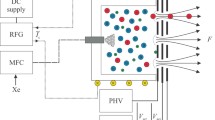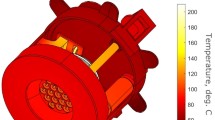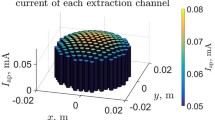Abstract
A zero-dimensional analytical model for an RF discharge ion thruster has been improved to predict the thruster performance better. Improvements were made by incorporating most physical phenomena expected in an RF ion thruster, such as secondary electron emission, double ionization, a variable Clausing factor, grid optical transparency, and an ion confinement factor affected by the electromagnetic field. Clausing factors were calculated for each flow rate by using a Monte-Carlo technique. The grid optical transparency was calculated using an ion optics simulation. The ion confinement factor was also calculated for each flow rate by using the calculated magnetic field strength obtained from magnetic field simulations. The ion confinement factor turned out to have the greatest effect on the results while minor corrections were achieved by other processes. Comparison with previously reported analytical solutions and experimental data showed improved prediction of the thruster performance for various size and power ranges.
Similar content being viewed by others
References
E. Y. Choueiri, J. Propul. Power 20, 193 (2004).
D. Lev et al., in Proceedings of 35th International Electric Propulsion Conference, Atlanta, Georgia, USA, October 8–12, IEPC-2017-242 (2017).
S. Mazouffre, Plasma Sources Sci. T. 25, 033002 (2016).
R. G. Jahn and E. Y. Choueiri, Electric Propulsion, Encyclopedia of Physical Science and Technology (Academic Press, New York, 2003).
R. Killinger, H. Leiter and R. Kukies, in 43rd AIAA/ASME/SAE/ASEE Joint Propulsion Conference & Exhibit, AIAA Paper 2007-5200 (2007).
M. Tsay, K. Hohman and L. Olson, in 23rd Annual AIAA/USU, SSC09-II-1 (2009).
M. Martinez-Sanchez and J. E. Pollard, J. Propul. Power 14, 688 (1998).
R. E. Wirz, in Proceedings of the 34th International Electric Propulsion Conference, Hyogo-Kobe, Japan, July 4–10, IEPC-2015-275 (2015).
R. Henrich, M. Becker and C. Heiliger, in Proceedings of 35th International Electric Propulsion Conference, Atlanta, Georgia, USA, October 8–12, IEPC-2017-518 (2017).
T. Arzt, J. Phys. D: Appl. Phys. 21, 278 (1988).
M. Tsay, Ph.D. thesis, MIT, 2010.
D. M. Goebel, IEEE Trans. Plasma Sci. 36, 2111 (2008).
M. Dobkevicius and D. Feili, J. Propul. Power 33, 939 (2017).
P. Chabert et al., Phys. Plasmas 19, 073512 (2012).
P. Chabert and N. Braithwaite, Physics of Radio-Frequency Plasma (Cambridge University, Cambridge, 2011).
S. V. Kanev, S. A. Khartov and V. V. Nigmatzyanov, Procedia Engineer. 185, 31 (2017).
D. Bohm, The Characteristics of Electrical Discharge in Magnetic Fields (McGraw-Hill, New York, 1949).
J. M. File, M. Martinez-Sanchez and J. Szabo, in Proceedings of 33rd Joint Propulsion Conference & Exhibit, Seattle, Washington, USA, July 06–09 (1997), p.3052.
J. P. Bugeat and C. Koppel, in Proceedings of 24th International Electric Propulsion Conference, 286 (1995).
N. Gascon, M. Dudeck and S. Barral, Phys. Plasma 10, 4123 (2003).
D. M. Goebel and I. Katz, Fundamentals of Electric Propulsion: Ion and Hall Thrusters (JPL, California, 2008).
C. Farnell, Performance and lifetime simulation of ion thruster optics (Ph.D. Dissertation, Colorado State University, 2007).
P. Clausing, J. Vac. Sci. Technol. 8, 636 (1971).
http://esgeetech.com/products/vizglow-plasma-modeling/VizGlow/ for VizGlow, Esgee Technologies (2018).
H. Renault, M. Silvi, K. Bohnhoff and H. Gray, in 2nd European Spacecraft Propulsion Conference, ESA SP-398, Noordwijk, Netherlands, May 27–29 (1997), p.251.
N. Caruso and M. Walker, Front. Phys. 6, 161 (2019).
C. Volkmar and U. Ricklefs, Eur. Phys. J. D 69, 1 (2015).
H. W. Loeb et al., Development of a RIT-Millithruster, 55th International Astronautical Congress of the Int. Astronautical Federation, Int. Academy of Astronautics; International Institute of Space Law, IAC-04-S.4.04, (2004).
H. J. Leiter, H. W. Loeb and Karl-Heinz Schartner, The RIT 15 Ion Engines — A Survey of the Present State of Radio Frequency Ion Thruster Technology and its Future Potentiality, ESA SP-465, 423 (2001).
Acknowledgments
This work was supported by the 2017 Research fund of the University of Ulsan.
Author information
Authors and Affiliations
Corresponding author
Rights and permissions
About this article
Cite this article
Pham, Q.T.D., Shin, J. Better Prediction of the Performance of a Radio-frequency Ion Thruster. J. Korean Phys. Soc. 76, 137–144 (2020). https://doi.org/10.3938/jkps.76.137
Received:
Revised:
Accepted:
Published:
Issue Date:
DOI: https://doi.org/10.3938/jkps.76.137




